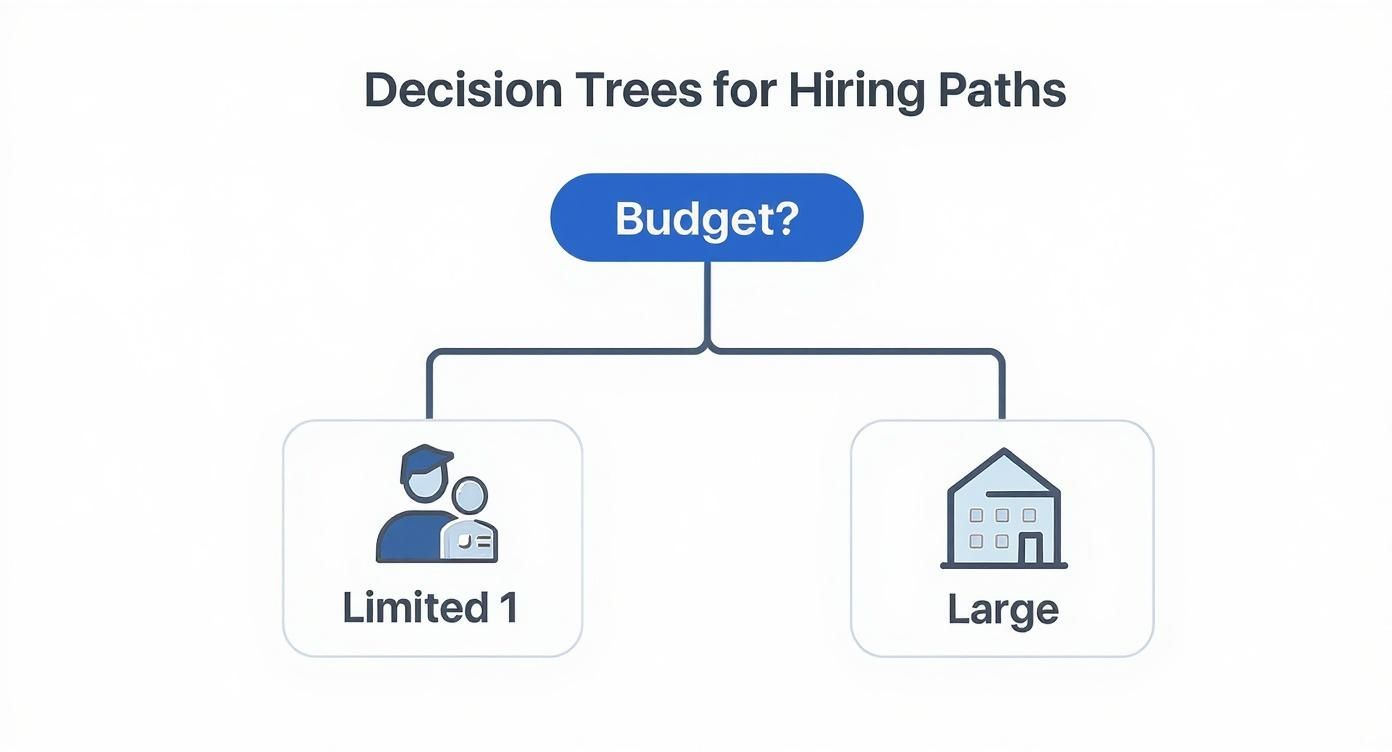Hiring a web developer starts with a clear plan. You've got to define your project's scope, set a realistic budget, and nail down the core features you absolutely need. Getting this groundwork right is the single most important step you can take. It’s what attracts the right talent and saves you from a world of costly revisions down the road.
Laying the Groundwork for a Successful Hire
Before you even think about posting a job description, you have to look inward at your business goals. Jumping straight into the hiring process without a clear vision is like trying to build a house without a blueprint—it’s chaotic, expensive, and rarely ends well. A successful hire begins with a rock-solid understanding of what you need your website to do for your customers and for your business.
This means getting brutally honest about the difference between absolute necessities and nice-to-have extras. For an e-commerce store, a secure, seamless checkout process is a must-have. A fancy, animated product showcase, on the other hand, might be a nice-to-have that can wait for phase two.
Defining Your Project Scope and Budget
Start by mapping out your customer's journey. What problems are they trying to solve when they land on your site? How will your website deliver the solution? Answering these questions helps you prioritize the features that deliver real value. Our guide on how to create a business website is a great resource for structuring these initial thoughts.
Next up, you have to talk money. Let's be real: skilled developers are in high demand. Web development is a booming field, with the U.S. Bureau of Labor Statistics projecting an 8% increase in employment from 2023 to 2033. That demand drives up costs. The median annual wage for developers in the U.S. hit $90,930 in May 2024, and top-tier talent can easily command over $160,000. You can explore more about these employment trends over on the BLS.gov website.
Key Takeaway: Your project brief and your budget are your two most powerful filtering tools. A detailed scope of work attracts serious, qualified developers, while a realistic budget ensures you’re looking in the right talent pool from the start.
And don't forget about the hidden costs that go way beyond the developer's hourly rate. You’ll also need to budget for:
- Domain Registration: The yearly fee for your website's address (e.g., GoDaddy, Namecheap).
- Web Hosting: The service that keeps your site live and online (e.g., WP Engine, Kinsta).
- Ongoing Maintenance: A budget for security patches, updates, and support is non-negotiable.
- Third-Party Services: Extra costs for plugins, premium themes, or APIs (e.g., Stripe for payments, Mailchimp for newsletters).
The infographic below offers a great decision tree, showing how your budget can help guide your initial hiring path.

As you can see, smaller budgets often align perfectly with hiring a freelancer, while larger, more complex projects might demand the resources of a full agency. Putting in this foundational work ensures every conversation you have with a potential developer is productive and laser-focused.
Where to Find and How to Vet Your Ideal Developer

Alright, you've got a clear plan for your project. Now comes the hard part: finding the right person to actually build it. Knowing where to look is half the battle, because different platforms are built for completely different needs, budgets, and types of projects.
For smaller, well-defined tasks or if you’re working with a tight budget, the big freelance hubs like Upwork and Fiverr are a decent starting point. The talent pool is massive, but be prepared to do some serious digging and vetting yourself.
If your project is more complex, you might look at a curated marketplace like Toptal. They pre-screen their developers, so the quality is generally much higher, but so is the price tag. Don't overlook professional networks, either. A well-worded post on LinkedIn can be a goldmine, often surfacing developers who aren't actively job-hunting but are open to the right opportunity.
Crafting a Job Description That Attracts Top Talent
Your job description is your first and most important filter. If you post something generic, you're going to get a flood of generic, low-effort applicants. You need to be specific and, honestly, a little compelling.
Instead of just spitting out a list of required skills, tell a story. Describe the problem your business solves and the impact this new website will have. A great developer wants to work on something meaningful, not just another gig.
A strong job description needs to nail these points:
- The Project Mission: "We're a family-owned bakery looking to build an e-commerce site that brings our local recipes to a national audience."
- Core Responsibilities: Get specific. What will they be doing day-to-day? "Develop a custom WordPress theme, integrate WooCommerce with Stripe, and build a product filtering system."
- Must-Have Skills: List the absolute non-negotiables. Be clear about technologies like WordPress, React, or Shopify Liquid.
- 'Nice-to-Have' Skills: What would be a great bonus? Maybe experience with a specific payment gateway like Authorize.net or an email marketing tool like Klaviyo.
- Project Scope & Timeline: Give a realistic snapshot of the project's size and how long you expect it to take. "Initial build of 10-15 pages with a target launch in 3 months."
This level of detail does two things: it helps developers know if they're a good fit, and it shows them you're a serious client who has actually thought this through.
How to Critically Evaluate a Developer's Portfolio
Once the applications start coming in, the portfolio is where you separate the real contenders from the pretenders. Don't just glance at pretty screenshots. You need to get in there and interact with their past projects like you're a real customer.
What you're really looking for is evidence of skill and thoughtfulness. Is the navigation clean and intuitive? Does it just make sense? Pull up their sites on your phone. Is the design truly responsive, or does it just shrink down into a tiny, unusable mess? A logical how to plan website structure is the foundation of a good user experience, and their portfolio is where you'll see if they get that.
Pro Tip: Pay close attention to how fast their sites load. You can use your browser's built-in developer tools to check performance. A site that takes more than a few seconds to become usable is a huge red flag. It often means the developer doesn't prioritize optimization or user experience.
Finally, be a little skeptical of portfolios that are just a collection of generic-looking templates. While templates have their place, a truly skilled developer's work should showcase custom solutions and creative problem-solving. If every site looks like a slightly tweaked theme you've seen a hundred times before, it might signal a lack of deeper technical ability. This is about finding a partner, not just a technician.
Conducting Interviews That Reveal True Capabilities

So, you’ve shortlisted a few candidates with impressive portfolios. Now comes the real test: the interview. This is your chance to uncover what a slick resume or a polished portfolio can't tell you.
A portfolio shows you what a developer has built. A great interview reveals how they think, solve problems, and communicate. This is where you move beyond the canned answers and really dig into their actual capabilities.
The goal isn't to trip them up with impossible brain teasers. It’s about creating a genuine conversation that lets their real-world skills shine through. Generic questions get generic answers.
Instead of asking, "Do you know JavaScript?" try this: "Tell me about a time you ran into a really stubborn problem using JavaScript and how you finally cracked it." The first question gets you a "yes." The second one gives you a story, complete with their thought process and problem-solving chops.
Go Beyond the Technical Checklist
While you obviously need someone who knows their way around code, technical skill is only one part of the equation. You're also looking for someone who can handle challenges, work well with others, and take feedback without getting defensive.
A developer who writes brilliant code but can't explain it to you is going to create bottlenecks and endless frustration. You need a partner, not just a programmer.
Here are a few things to probe for during the interview:
- How They Tackle Problems: Ask them to walk you through how they’d approach a hypothetical project, like adding a new e-commerce feature to your current site. "If we wanted to add a 'subscribe and save' option to our products, what would be your first three steps?"
- Their Communication Style: Pay close attention to how they explain complex technical ideas. Can they break it down for someone who isn't a coder? That's a huge skill.
- How They Adapt: Ask about a time a project’s goals changed halfway through. How did they react? What did they do to get things back on track?
The Litmus Test: A Paid Technical Task
Honestly, the single best way to know if a developer is the real deal is to see them in action. Assigning a small, paid technical task is an incredible predictor of their actual on-the-job performance. Let me be clear: this isn't about getting free work. It's a test drive.
The task should be directly relevant to the kind of work you'll need, but small enough to be completed in just a few hours.
Good examples include:
- A Simple Debugging Challenge: Give them a small piece of code with a known bug and ask them to find it and explain the fix. This shows you how they think analytically.
- Building a Small Feature: Ask them to create a single, self-contained component, like a custom contact form or an image gallery. This reveals their coding style and attention to detail.
- A Page Speed Audit: Provide a link to a sample page and ask for their recommendations on how to speed it up. If you want to learn more on this, check out our guide on how to improve website loading speed.
By paying for their time, you show respect for their expertise and get a much more accurate sample of their work than a typical interview can provide. You’ll see how they structure their code, how they communicate questions, and how they handle deadlines.
This hands-on approach takes the guesswork out of hiring. It helps you find a developer who not only talks a good game but can deliver the results your business depends on, turning a hiring decision into an informed choice based on real evidence.
Navigating a Global Talent Pool

Hiring a web developer used to mean looking in your own backyard. Not anymore. Remote work has blown the doors wide open, giving you access to a worldwide market of skilled professionals you never would have found otherwise.
This global approach can be a total game-changer, especially for small businesses trying to find that sweet spot between top-tier skills and a manageable budget. But hiring globally isn’t as simple as posting a job ad. You’re navigating different time zones, communication styles, and cultural norms. The key is to have a smart strategy.
Exploring Global Tech Hubs
Certain regions have become magnets for high-quality development talent, and each has its own unique advantages. It pays to know what they are.
- Eastern Europe: Countries like Ukraine and Poland are well-known for their strong technical education and a serious work ethic. Developers here often have excellent problem-solving skills and a high level of English proficiency.
- Latin America: Brazil and Argentina are quickly becoming major players. The biggest perk? A significant time zone overlap with North America, which makes real-time collaboration a whole lot easier.
- Southeast Asia: Nations like Vietnam and the Philippines offer highly competitive rates. The talent pool is growing at an incredible pace, making it a great place to find developers for all kinds of projects.
Key Insight: When you hire web developer talent from another country, cultural nuances and communication norms are just as important as technical skills. Proactive, clear communication is the foundation of a successful remote partnership.
The Evolving Demands on Developers
The bar for what makes a great developer has been raised. Basic coding skills are just the price of admission now. Today, businesses need developers who can deliver on modern user expectations.
This means skills like ensuring fast page-load speeds, robust accessibility compliance (WCAG), and the ability to integrate AI-powered tools are no longer nice-to-haves—they're core requirements.
The global developer population is also expanding at a breakneck pace. While North America and Western Europe have mature markets with around 9.5 million developers each, the real explosion is happening elsewhere. South Asia’s developer base is projected to nearly double to 7.5 million by 2025, while South America’s will hit 3.4 million. You can dig into the full global developer report on slashdata.co for more on these trends.
This growth brings up a critical question about pay. Do you offer a salary based on the developer’s local cost of living, or do you offer a rate that's competitive with Western markets? While local rates can save you money, offering a higher, market-competitive salary often attracts the most skilled and motivated people. Finding that perfect balance between cost and quality is essential.
If you’re set on hiring within the country, our guide to finding a USA website developer can give you more localized insights.
Finalizing the Offer and Crafting a Clear Contract
You’ve navigated the interviews, reviewed the technical work, and found a developer who feels like the perfect fit. So, now what? It's time to turn that handshake agreement into a rock-solid professional relationship.
This is the stage where clarity is everything. It’s all about setting crystal-clear expectations and putting protections in place for both you and your new hire. The first move is structuring the offer, which really hinges on picking the right way to pay for the work. Don't just default to one model without thinking it through; the choice you make here shapes the entire dynamic of your partnership.
Choosing the Right Payment Model
There are three common structures out there, and each one has its own set of pros and cons depending on your project's needs.
- Hourly Rate: This is your best bet for projects where the scope is a bit flexible or likely to evolve. You pay for the exact hours worked, which offers incredible adaptability. It’s perfect for ongoing site maintenance or projects where you know you'll be adding new features over time.
- Fixed-Price Project: This model is the way to go when you have a well-defined scope of work that isn’t going to change. You agree on a single, all-in price for the entire project, which gives you complete budget predictability from day one.
- Monthly Retainer: A retainer is a great option for securing a developer’s availability for a set number of hours each month. This is a smart choice for any business needing consistent support, regular updates, and minor feature development without starting a new contract every time.
The Non-Negotiables of a Strong Contract
Once you’ve settled on the payment structure, the contract becomes your single source of truth. A vague agreement is an absolute recipe for disaster down the road. Your contract has to be detailed, leaving zero room for assumptions.
A clear contract isn’t about mistrust; it’s about creating a shared understanding. It’s the ultimate tool for preventing scope creep, payment disputes, and misunderstandings, ensuring a smooth partnership from day one.
No matter who you hire, your contract should explicitly cover these critical areas:
- Detailed Scope of Work (SOW): List every single feature, page, and piece of functionality. Be painfully specific about what is included and, just as importantly, what is not included. For example, "SEO content writing is not included."
- Deliverables and Milestones: Break the project down into clear, logical phases with specific deadlines attached. "Milestone 1: Homepage design mockup due by Oct 15."
- Payment Schedule: Directly link payments to the completion of those milestones. "Payment of 25% due upon completion of Milestone 1."
- Intellectual Property Ownership: Make it crystal clear that upon final payment, your business owns all the code, designs, and any other assets created for the project. No ambiguity allowed.
- Termination Clause: Outline the specific conditions under which either you or the developer can end the contract. This provides a clear, fair exit strategy if things just don’t work out.
Thinking ahead about what happens after the site is built is also crucial. For some really actionable steps on that front, our guide on how to launch new website provides a valuable checklist to walk you through it.
Common Questions About Hiring a Web Developer
Hiring a web developer can feel like a big step, especially if you're not swimming in technical lingo every day. It’s totally normal to have questions pop up. Let’s tackle some of the most common ones I hear from business owners so you can move forward with confidence.
How Much Should I Expect to Pay for a Small Business Website?
This is the million-dollar question, and honestly, the answer can be all over the map. For a straightforward, informational website—think of it as a digital brochure with a few key pages and a contact form—a good freelance developer might charge anywhere from $2,000 to $8,000.
But if your vision includes things like e-commerce, custom user accounts, or integrations with other software you use, the complexity (and the price) goes up. For a project like that, an agency could quote you anywhere from $10,000 to $50,000+. Just remember to also set aside a budget for ongoing maintenance. A good rule of thumb is about 15-20% of the initial project cost per year to cover security updates, hosting, and general support.
Your project's scope is the single biggest factor driving the final cost. A detailed plan prevents budget surprises and ensures you're paying for what your business truly needs.
What Is the Difference Between a Front-End and a Back-End Developer?
Let’s think about it like building a car.
A front-end developer handles everything you can see and touch—the dashboard, the seats, the steering wheel, and the shiny paint job. They use languages like HTML, CSS, and JavaScript to build the visual elements and user interface that your customers will actually click on and interact with.
A back-end developer is the one building the engine, the transmission, and all the complex machinery under the hood that makes the car actually go. They manage the server, the database, and all the application logic using languages like Python, PHP, or Node.js. And a full-stack developer? They're the jack-of-all-trades who can work on both the engine and the interior.
Should I Use a Website Builder or Hire a Developer?
Website builders like Squarespace or Wix are fantastic tools for very simple sites, especially when you're on a shoestring budget. They give you templates that are easy to get started with, but they have their limits when it comes to customization and can be tough to scale as your business grows.
It’s time to hire a developer when you need things like:
- Unique Features: Think custom calculators, booking systems, or specific integrations with your CRM.
- Specific Branding: You need a design that perfectly matches your brand identity, not one that’s shoehorned into a template.
- Advanced SEO: You want a site architected from the ground up for the best possible search engine performance.
- Scalability: You need a platform that can grow and evolve with your business without hitting a wall.
A custom-built website is a strategic, long-term investment for any business with serious growth ambitions and specific operational needs.
Ready to build a website that drives results? The team at Website Services-Kansas City specializes in creating high-performance WordPress sites and providing expert SEO solutions to help your business thrive. Get in touch with us today!